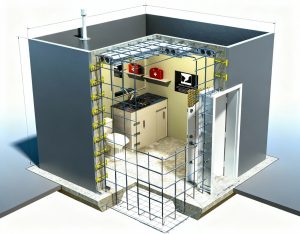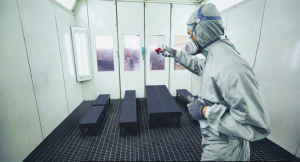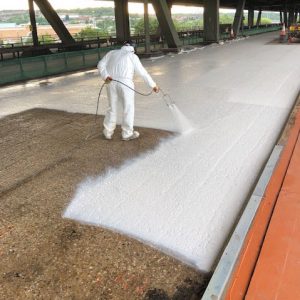The recent increase in domestic oil production has focused on the environmental hazards and potential cleanup costs posed by oil spills in drilling, refining, and storage operations and the need for a safeguarding or secondary containment method in addition to the primary containment system.
The traditional approach has been to amass native soil into berms creating enclosures enwrapping drill sites, pump stations, and storage tanks. This approach is practical in slowing the migration of spilled material. However, it does not prevent soil absorption and contamination, which means that the site will need a costly remediation process in the event of a spill. This process can be as extreme as including the removal and disposal of soils. Contamination of adjacent water supplies can be even more intricate and costly.
Over the past few decades, various containment liners have addressed these concerns by providing a complete containment system that makes it possible to pump the spill cleanly from the containment area while preventing spill migration and soil contamination. The industry has migrated towards the use of geo-membranes that provide a very low permeability barrier to control fluid penetration and soil contamination.
Usually, geo-membranes are made from thin, mostly continuous polymeric sheets or a mix of a thermoset polymer and a synthetic geotextile. The seams between the sheets of geotextile fabric are normally sealed and glued together using weld seaming or glues for polymeric sheet goods or using
the coating system for spray-in-place liners.
It is advantageous to mention that this same process is also used to rehabilitate concrete containment and severely pitted steel containment in other types of industrial segments. The overriding objective is to seal off any porous substrates.
ArmorThane’s ArmorLiner is a state-of-the-art rigid containment solution that some of the world’s largest oil and natural gas producers use. ArmorLiner is a polyurea elastomer coating on geotextile membranes to deliver permanent spill prevention. The system is effective at both containing spills and preventing soil contamination.
Power of Polyurea
The current trend in secondary containment construction is created by laying geo-fabric in the containment area and spraying a protective coating to provide seamless coverage over the geo-fabric. The coating most often used is polyurea elastomer. This system offers enhanced flexibility, rapid application, and cure speed for quick seaming compared to other systems. Assembly is fast and easy because of this method’s ability to conform to various shapes and to existing structures such as pipes and tanks.
Polyurea provides chemical resistance to contain oil, drilling fluids, and reagents used in fracturing. High tensile strength, tear strength, and elongation of polyurea-coated geo-fabric provide the strength needed to resist the impact of equipment and tools without leaking and provide excellent cut tear resistance. Stress cracking is not normally a factor with polyurea products.
The site should be prepared before installation. To provide reliable secondary containment, it’s important to ensure the underlying soil’s stability and prevent soil from sliding under the liner. A layer of clay, sand, or gravel is often placed at a uniform depth upon the compacted soil before the polyurea geotextile membrane is placed. The ground must be dry and free of stones, sticks, metal, and other objects that might puncture the liner.
The longevity of the membrane is highly correlated to its thickness. Polyurea geotextile membrane is typically applied at a thickness of 60 to 80 mils (1.5 to 2 mm). The typical application will provide sufficient resistance to mechanical shock, chemicals, and weather. In many applications, thicknesses as great as 100 mils (2.5 mm) are specified to increase service life and reliability.
Installation Tips
The crew installing the liner should wear rubber-soled footwear to avoid damaging the geo-textile during the installation process.
The arrangement of the geotextile membrane sheets should start at the center of the containment area and move out toward the perimeter to account for the shrinkage of the membrane system.
Depending on the conditions of the installation, the geotextile panels may need to be anchored in place prior to coating. The adjacent panels should overlap each other by at least 6 in. The polyurea coating should then be sprayed with uniform passes over the surface of the geotextile sheets. Lap joints should be coated on both sides and sealed together before the coating dries.
Care should be taken to ensure the membrane is coated completely, and air pockets should be removed with a hand tool. The coating remains in gel form for mere seconds and is tack-free 8 to 12 seconds after application. Cure time is typically about 12 hours. Acceptable application temperature ranges from 20 to 125 F (-7 to 50 C). The coating is applied with heated high-pressure spray equipment at pressures of 2,000 to 3,000 psi and a spray temperature of 150 to 180 F (65 to 82 C).
Increased Emphasis
“Given the increased emphasis on improving our environment and public health, plus the media coverage of drilling activities, the use and cost-effectiveness of secondary containment systems will grow,” Froese says. “The use of geo-fabric with polyurea systems offers the best technological solution available in the market now.”
Froese adds that polyurea-coated geotextile membranes are currently state of the art for secondary containment, but more needs to be done to open up communications between the specifiers, including owners and engineering companies, as the manufacturers of membranes, coatings, and equipment.
“The contractors-applicators have assumed the role of promoting manufacturers’ products while manufacturers are not yet actively selling specifications on the front end,” Froese says. “As these applications become more commonly specified and used, more case histories will be available for study and comparison. These studies will develop more consistent industry standards, specifications, and best application practices.”











